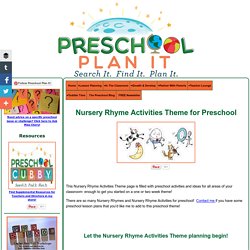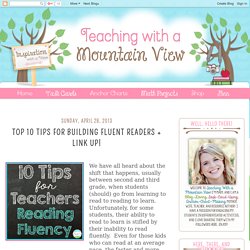

"I Am, You Are, He/She Is" Song - Present Simple "To Be" Lesson - Rockin English (Grammar) Llama Llama Misses Mama, Anna Dewdney - 9780670061983. Free music, free books, free games, free poems and free puzzles that help teach children how to read and improve reading comprehension. Toddler & Preschool Kids Educational Story books. Kids' Corner - Featuring the Stories of Beatrix Potter (and more!) Decodable passages - FreeReading. From FreeReading Decodable passages are short stories that can be read by a student who knows: How to sound out regular words, and The 30 irregular words taught in the Irregular Word sequence.

Many decodable stories included in commercial reading programs are redundant and lack the authenticity of a real reading experience. We have tried to create stories that are more authentic as well as being 100% decodable. That means you can discuss the meaning of the story after reading it, building your students' comprehension skills.
Inkless Tales: Stories. Make your OWN story!!

Story Sparkers HERE Kids: Like these stories? Try some of your own! You can DO it. Children's Storybooks Online - Stories for Kids of All Ages. Folk Tales and Fables. Come play again later!

Fun Activities for Teaching Rhyming Words to Preschoolers: A Lesson Plan. Written by: Keren Perles • edited by: Sarah Malburg • updated: 3/2/2012 Looking for some fun activities for teaching rhyming words?

You've come to the right place! This lesson plan will give you ideas for how to make rhyming fun for preschoolers. Songs & Poems. Seasons Special Days Animals Vegetation Food Family & Friends Language Arts Math At School.

Nursery Rhyme Activities for Preschool. This Nursery Rhyme Activities Theme page is filled with preschool activities and ideas for all areas of your classroom- enough to get you started on a one or two week theme!

There are so many Nursery Rhymes and Nursery Rhyme Activities for preschool! Contact me if you have some preschool lesson plans that you'd like me to add to this preschool theme! You can either scroll down through this page to see each of the Nursery Rhymes or click each link below to go to the specific Nursery Rhyme Activities section for each rhyme. Looking For a Fairy Tales Theme? Baa Baa Black Sheep Nursery Rhyme Activities Baa, baa, black sheep, Have you any wool? Yes sir, yes sir, Three bags full; Nursery Rhyme Activities for Preschool. English for kids - Cartoons.
English Singsing. Kindersite - Kindergarten Education Games Songs Stories. Teaching Tips 1: Using Songs in the Classroom. Time For Kids. Funny poetry for children. Riddles. Little Red Riding Hood. All around the world children love listening to and reading fairy tales in their mother tongue.

Whatever the reason, fairy tales provide both children and teachers with a familiar starting point from which to explore stories in a second language. This kit contains a variety of resources, from text and tasks to illustrations, flashcards and presentations, for you to download and use in your classroom. You can also find online and printable materials for learners on the British Council's LearnEnglish Kids website. Activities – a collection of activities related to the story Chants – a collection of spoken drill type activities Let's go to Grandma'sPlease don't play in the woodTummy, teeth and tailWhat a good girl! Developing Reading Fluency. Developing Reading Fluency Fluent reading is reading in which words are recognized automatically.

With automatic word recognition, reading becomes faster, smoother, and more expressive, and students can begin to read silently, which is roughly twice as fast as oral reading. Signup. AndersenFairyTales.com. Where Reading Is Fun! Children's Books Forever. Bedtime Home Page. Reading and Writing Instruction for ELLs. Reading Fluency Activities. Top 10 Tips for Building Fluent Readers + Link Up! We have all heard about the shift that happens, usually between second and third grade, when students (should) go from learning to read to reading to learn.

Unfortunately, for some students, their ability to read to learn is stifled by their inability to read fluently. Even for those kids who can read at an average pace, the faster and more accurately they can read and decode, the more effectively they can comprehend. When I taught third grade, and now as an interventionist, the importance of fluency is empathized more than ever (and has definitely met some critics). I know that fluency is NOT the end-all, be-all, but a lot of research proves that it is important, and a lot of schools are trending toward fluency being a high priority. I have compiled a list of some of the resources and strategies I have used when teaching in the regular education classroom and as an interventionist. 1. I know what you’re thinking—this is obvious. 2.
2-3Fluency_3.pdf. Put Reading First. Fluency instruction Fluency is the ability to read a text accurately and quickly.

When fluent readers read silently, they recognize words automatically. They group words quickly to help them gain meaning from what they read. Fluent readers read aloud effortlessly and with expression. Their reading sounds natural, as if they are speaking. Fluency is important because it provides a bridge between word recognition and comprehension.
More fluent readers focus their attention on making connections among the ideas in a text and between these ideas and their background knowledge. Storyline Online - Where Reading Is Fun! Reading Fluency Activities. Start with a Book. What is fluency? Why does it matter? Reading fluency is a child's ability to read a book or other text correctly, quickly, and with expression. A fluent reader doesn't have to stop and "decode" each word. Rather, most of the words can be read automatically. This means the reader can focus his attention on what the story or text means. Read Me A Story, Ink. — Search Read Aloud Stories by Title, Author, Grade Level or Keyword. Read With Me. Teach With a Mt View: Building Fluent Readers + Link Up!
SuperSpeed: Game of Champ Readers! Improving student reading speed, of all serious educational problems, is one of the easiest to solve. Only 100 words, sight words, make up over 50% of the words students will ever read. Many of these words cannot be sounded out phonetically and thus must be known at sight, instantly. The more quickly students can read sight words, the faster they will read. Superspeed reading games developed by Whole Brain Teachers of America and classroom tested by hundreds of educators, provide a simple, extremely entertaining way to help K-12 students improve their reading speed. SuperSpeed Letters and Phonics teaches K-2 students the alphabet and letter sounds; SuperSpeed 100 helps K-3 (and remedial) students master the 100 most common sight words; SuperSpeed 1000, designed for 3rd-high school students, teaches the 1,000 most common sight words.
SuperSpeed is played as follows: For more information, contact Chris Biffle. Read With Me. Reading Brain. SUPER WHY! Educational Computer Games and Apps for Kids.